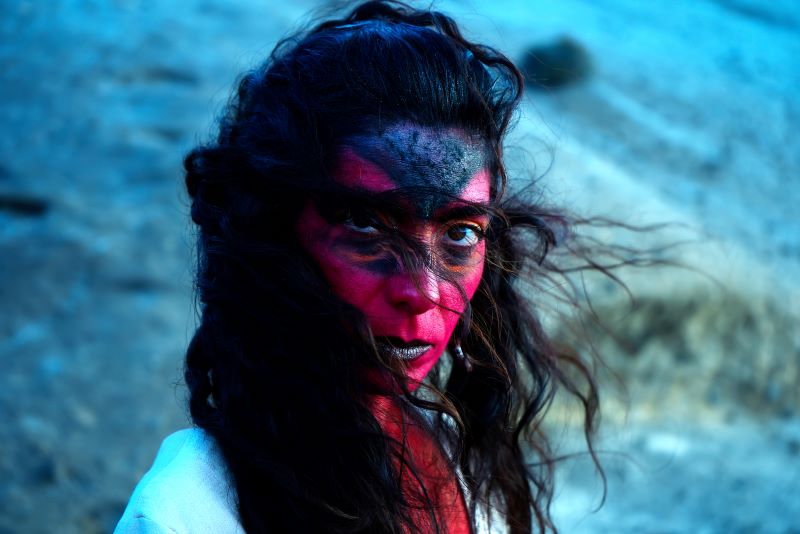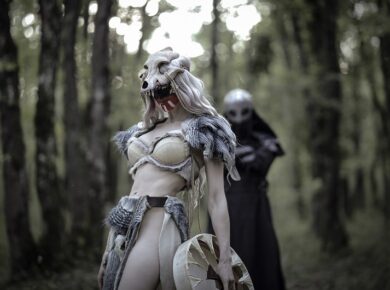Sardinian experimental industrial artist Dalila Kayros returns with a bold new vision on her latest release, “Khthonie”, out now on Subsound Records. Known for pushing sonic boundaries, Kayros captures the raw essence of the earth’s dual forces—creation and destruction—in an album that evokes life emerging from the underground. “Khthonie” is both primal and futuristic, a visceral exploration of nature’s power rendered through jagged electronics, haunting vocals, and ritualistic intensity. Learn more on our interview with the artist.
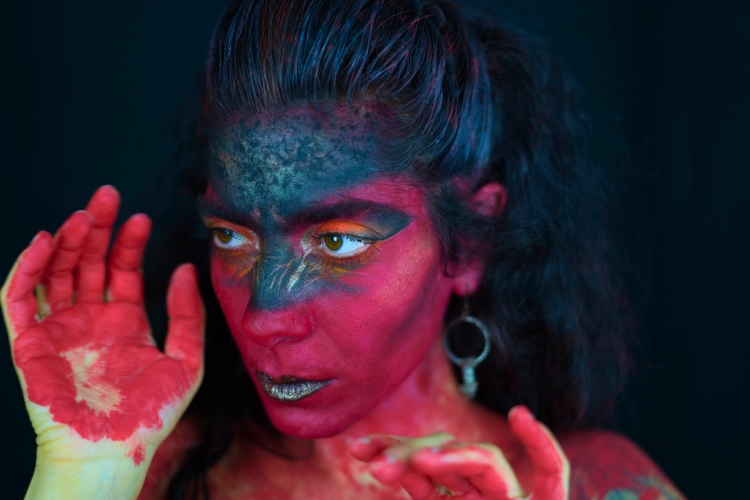
Welcome to Dalila Kayros
So, Dalila, first of all, welcome to Femme Metal Webzine! I’d like to start by asking: how are you, and how is the promotion for the new album going?
Thank you! It’s going well. We have several things planned — for example, next week I’ll be interviewing with Metal Hammer Italy.
It’s quite curious because I’ve had a metal band for a long time, and now with my solo project, things have been a bit peculiar. I used to sing both clean and scream vocals — mostly clean on the last few albums — and it was a bit strange, mixing that clean singing with djent-style music. But now, with my own project, there’s been a lot of interest from metal webzines, and I’m really happy about it.
The inception of “Khthonie”
I wanted to ask you, the album is called “Khthonie”, and I wanted to ask you about the production. When did you start to have the first ideas for this new album? I also know that the last tour in the States had a certain impact on the final result, let’s say.
Exactly. In the meantime, the ideas had already started during the tours and, above all, as you said, during the American tour, where we left behind all the extra stuff. We were traveling with more instruments, but since there was a long journey to face and a whole series of logistical issues, we ended up reducing the instruments.
And then, I don’t know what happened, but something got unlocked — another kind of creativity got unlocked — and we completely reinvented everything we had done up to that moment. The approach to this album was born right on stage, from there, and then, in the meantime, between one tour and another, let’s say between 2022 and 2024, we finished composing. I also composed at home, and the ideas were born because the previous album was about the shadows, about encountering the shadows, while now I felt the need to wake up these shadows.
“Encountering the shadows”
I mean, I met them, but now I have to talk to them, okay? I have to talk to them, hug them, do something together. And, from there this album was born, which talks about the Chthonies, which would be the divinities of death, of the underworld. They are the first divinity, before Gea was born — Gea, who becomes the Earth because she marries the sky, and thus the Earth is born, let’s say, immersed.
“Free from bonds”
Instead, Chthonie is the Earth before meeting the sky. Free, in the imagination, a land free from bonds. Maybe I’m explaining it better like this: free from bonds. And so, this experience on stage also led to certain songs being born during. I mean, I would wake up after dreaming of melodies or pieces, and I would run straight to the studio to write them down. Exactly. So it’s between a dream and, actually, the freedom of improvisation on stage. Although it wasn’t random improvisation, it was compositional improvisation, because we were trying to create songs, not just go off-track.
Stepping into reasearch
Listen, did you do any research to understand which Chthonic idea to use from Greek mythology? Because I didn’t do classical lyceum, but I have a general understanding.
Let’s say these are quite particular ideas, and you need to know what they mean. Yes, I did some research. Among other things, I just graduated in psychology — I took the path of music psychology. So I do research on the voice, on the expressiveness of the voice, especially in early childhood.
I also study everything that comes before language, okay? In this sense, while I was studying various things for my thesis, I also searched for where this idea of a “land free from bonds” could originate. Looking into Greek mythology, I found this fantastic text, which I recommend: the Cosmology of Feredice.
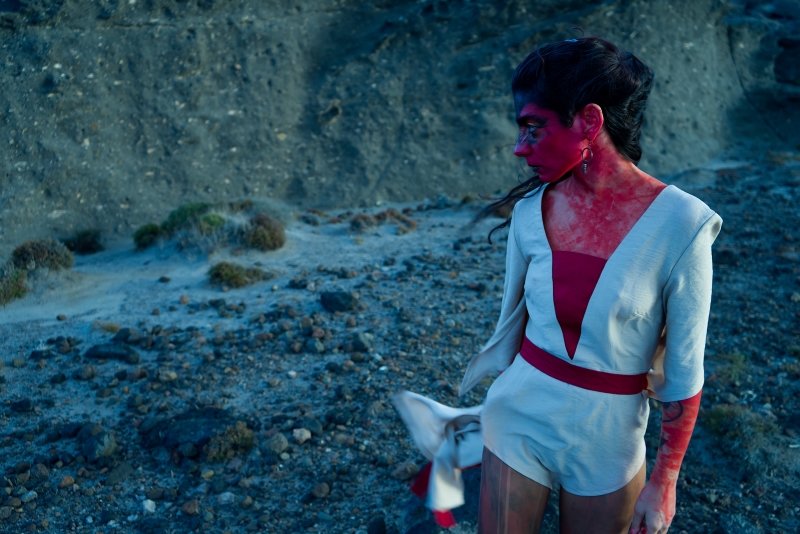
The beginning of it all
Yes, it basically starts from three divinities: Zas, Kronos, and Chthonie. Zas will later become Zeus, Kronos remains — Kronos is Time — and Chthonie becomes Ge, who will become the Land of Emergence. Later, she will also become Rea, and in some later versions, she even becomes Hera, Zeus’s wife. But this happens before she marries Zeus, okay? And therefore, before the bond that subjugates her to something, to a power.
The influence of the academic studies in “Khthonie”
In what way has your academic path influenced this album? Because you just told me, well, for my thesis, I had to do some research, but in the end, how did you realize that everything you researched was used for “Khthonie“?
Especially in the vocal expression. Since I used so many different timbres, which is something I already did, but before, maybe I did it a little messily. Now, let’s say I brought everything together and I found a way to combine more parts of the identity, an identity that is not fixed.
Identity can be many things, and above all, it is mutable, right? So, in this case, I wanted to put that mutability, the lack of a strict bond, the lack of a dominating power, into the album in this sense.
The collaboration of Dalila Kayros with Danilo Casti
Listen, I wanted to ask: I know that you collaborate with Danilo Casti. However, what was Danilo’s role this? Because last time — I don’t want to say he helped you — but it was more like he acted as a coadjutor for the last album, which had a more fixed structure. This time, from what you’re telling me, you experimented a lot, in a much freer way. So, I wanted to ask you: what was Danilo’s role this time?
Yes, in the meantime, we went on tour with Danilo, everything that happened on stage happened right with him. Pratically, we started playing and researching practically together back since in 2019.
With this album, “Khthonie“, apart from the stage, there was a collaboration behind the scene. In the sense that there are some songs that, as I told you, I composed and then we arranged them together, and other songs that he composed and then we arranged together. So it was a collaborative work. Also, it was cooperative, because every now and then we worked alone on things. It was both cooperation and collaboration.
Putting together the (language) opposites
Ok, I wanted to ask you: which was the challenge this time with “Khthonie”? I know that you also used the Sardinian Campidanese language in certain songs, and you combined the meaning of Greek mythology with the Sardinian language.
The challenge was to put together the opposites, both musically, because there are parts that start one way and end another way, or appear suddenly. Danilo had a fundamental role in this because sometimes there was a clash in terms of ideas. We tried to create a synthesis by putting our different ideas together. It’s the same with the voice: I combined, as I said before, different timbres together at the same time, as if they were multiple people — or a dragon with multiple heads. I don’t like to think about this thing of the dragon with more heads.
A world of possibilities
So, I wanted to ask you: you said, “I tried to find my real voice, I explored all the forms, the details of my voice, and a world opened up to me.” Did a world open up to you during this research?
That’s a good question. A world, in the sense of the world of possibilities, because if on the one hand there is always a tendency to find only one thing that defines you,
I realized in my case that we are not just one thing. We are many things, and we have to accept this.
At the same time I have accepted that I can be many things, and my voice, which reflects this state of mind, must embody multiple sounds, multiple ways of expressing itself.
And this is perhaps one of the most important things.
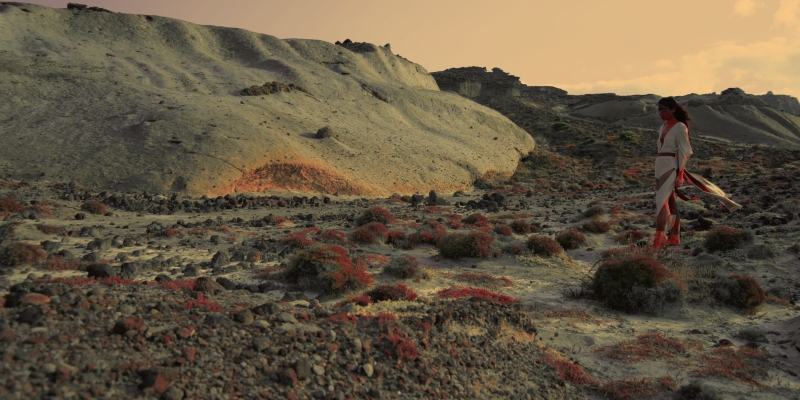
Dalila Kayros adding the Sardinian flavour on “Kthonie”
I wanted to ask you: as I just mentioned, you also use the Sardinian language. What role does the Sardinian language play in your music?
So, I started in 2013 with my first album, on which I combined the Campidanese Sardinian language with phonemes. Then I mixed them, there are songs that were only phonemes or where I alternated Sardinian with sounds always rooted in Sardinian tradition. In this album, I wanted to return to this mode because I feel it’s mine. I’ve been working on it for a few years, and finally, with “Khthonie”, I managed to bring it all together again.
In this case, it’s a mix of Sardinian and Italian. The same goes for the phonemes, always rooted in Sardinian language, and at certain points, I also added some words. Maybe a word in English, one in Spanish, but there are really only a few, maybe two.
More than anything, it’s the fusion of Sardinian, Italian, and phonemes — again, for the synthesis of diversity. And in this case, Sardinian was very important because it brings out something that comes from my childhood, so it’s natural for me, and it’s important to express it in music, especially in this album.
Any plans to watch Dalila Kayros live?
I wanted to ask you about concerts in Europe: do you have any plans? Or is everything still up in the air?
No, no, no, no. Let’s say we have everything open.
Are you coming to Europe or staying only in Italy this time?
No, no, we’re doing both Italy and Europe. We’ll go to England, obviously Italy — both southern and northern Italy — Germany, and there are others we’re working on.
Final words
Okay, Dalila, I thank you very much for your availability. I hope you enjoyed the interview.
Thank you very much! Thank you, Miriam, see you soon then.
